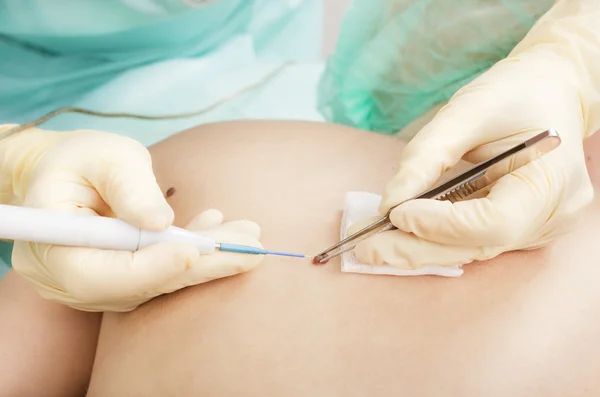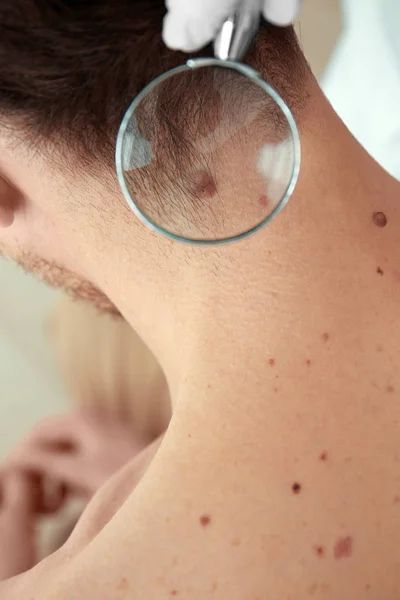


Dermatologist Mole Screening and Removal
in Logan, Utah
The skin care team at Lone Pine Dermatology center wants you to be confident in your skin by knowing when to be concerned about moles and when to embrace them proudly. Moles are common and usually harmless; you were probably born with between 10 and 40 of them. It is important, however, to be familiar with your skin and know where you have moles and how many.
We recommend that you check your skin at least once a month and have a family member help you check your scalp and other hard-to-see areas. This is the best way to ensure that you notice new moles and if they are changing. When you have more than 40 moles, or you have a fast-growing mole, it is time to get your skin checked by a dermatologist.
We recommend that you check your skin at least once a month and have a family member help you check your scalp and other hard-to-see areas. This is the best way to ensure that you notice new moles and if they are changing. When you have more than 40 moles, or you have a fast-growing mole, it is time to get your skin checked by a dermatologist.

ABCDEs of An Atypical Mole
There are five major indicators to determine if you have severely atypical moles. These signs correlate with a higher risk for melanoma and are commonly remembered as ABCDEs.
If you are asking yourself when to get a mole checked, please apply the ABCDEs. If one or more indicators apply to your mole, it is time to get it checked out by a dermatologist.
Mole Excision
New or transforming moles may indicate melanoma, or squamous or basal cell carcinoma. These require swift treatment and surgery. At Lone Pine Dermatology, we are dedicated to the prevention and early detection of skin cancer and other skin conditions.
Dr. Maughan is a Mohs fellowship surgeon experienced in skin cancer removal - specifically melanoma mole treatment. Other reasons to remove a mole are as preventative care or for aesthetic purposes. You may also discuss different methods of removal such as atypical mole excision and laser mole removal.
After your mole is removed you may have stitches or a small wound left from the procedure. It is important to follow post-care instructions to keep scarring at a minimum. Please keep your new skin protected from the sun and use creams to moisturize and protect the area. Once your skin is healed, if the scarring is more prominent than you prefer, we can reduce the scarring with laser treatments.
- Asymmetry - Look for moles that are not uniform throughout. The mole might be misshapen and one side will not match the other.
- Borders - Pay special attention to moles with blurry, irregular edges. It may be hard to tell where the mole starts and stops or be jagged on the edges.
- Color - Any mole that is not a uniform color can be a problem. A mole should be one shade of brown, not black, red, variegated, or white.
- Diameter - Note any moles that are larger in diameter than the pink eraser on the end of a pencil. Moles smaller than this may still be atypical moles especially if they exhibit other symptoms mentioned in the ABCDEs.
- Evolving - Typical moles are with us from birth. Any new, growing, or otherwise changing mole in any of the ABCD indicators is atypical.
If you are asking yourself when to get a mole checked, please apply the ABCDEs. If one or more indicators apply to your mole, it is time to get it checked out by a dermatologist.
Mole Excision
New or transforming moles may indicate melanoma, or squamous or basal cell carcinoma. These require swift treatment and surgery. At Lone Pine Dermatology, we are dedicated to the prevention and early detection of skin cancer and other skin conditions.
Dr. Maughan is a Mohs fellowship surgeon experienced in skin cancer removal - specifically melanoma mole treatment. Other reasons to remove a mole are as preventative care or for aesthetic purposes. You may also discuss different methods of removal such as atypical mole excision and laser mole removal.
After your mole is removed you may have stitches or a small wound left from the procedure. It is important to follow post-care instructions to keep scarring at a minimum. Please keep your new skin protected from the sun and use creams to moisturize and protect the area. Once your skin is healed, if the scarring is more prominent than you prefer, we can reduce the scarring with laser treatments.
Make an Appointment
Schedule an appointment with Lone Pine Dermatology today. Call 435-554-8442. We will diagnose, treat, and remove your moles with the highest degree of care. We are the expert skin care specialists you are looking for to give you peace of mind about the health of your skin. We care for patients in Logan, Utah, and the surrounding areas of Cache Valley.
